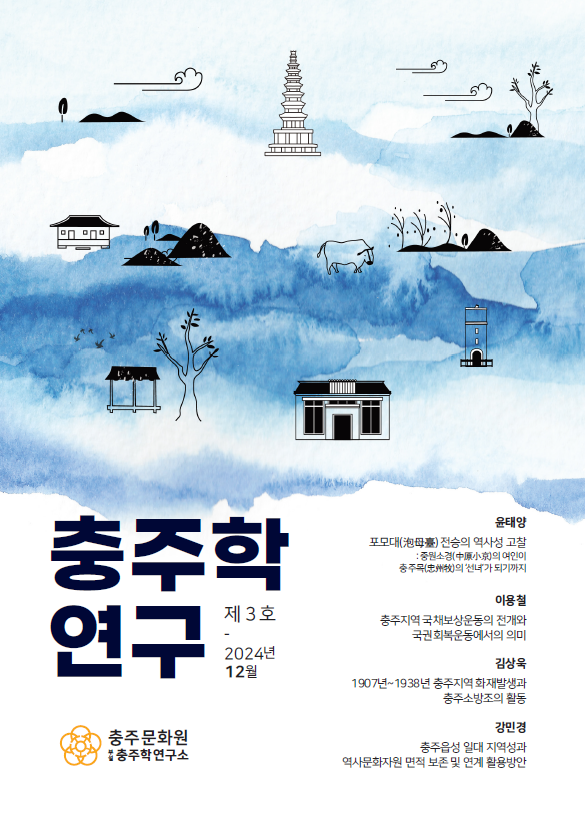충주지역 국채보상운동의 전개와 국권회복운동에서의 의미
The Development of The National Debt Redemption Movement in Chungju and its Signifi cance in the Movement for Restoration of National Rights
- 충주문화원 부설 충주학연구소
- 충주학연구
- 2024년 제3호
-
2024.1247 - 80 (34 pages)
- 2

충주지역 국채보상운동은 신문 게재일을 기준으로 1907년 3월 시작되었으며, 같은 해 12월까지 이어졌다. 의연 주체를 중심으로 총 106건을 구분할 수 있고, 여기에 2,436명 이상이 운동에 참여하여 총 101,000.5전(1,010원 5리) 이상의 금액을 의연했는데, 이중 충주는 1,320명이 54,786.5전(547원 86전 5리)을 의연했고, 충주에서 음성으로 이동한 지역에서는 1,116명이 46,214전을 의연하였다. 시기별로 보면, 6월과 8월에 운동이 가장 활성화되었다. 6월에는 798명(32.76%) 이상이 28,512전(285원 12전, 28.23%) 이상을 의연하였고, 8월에는 685명(28.12%) 이상이 30,406.5전(304원 6전 5리, 30.26%) 이상을 의연했다. 의연 경로를 보면, 대부분 ‘단체’보다는 ‘지역’을 기반으로 의연에 참여하고 있었다. 2,436명 중 88.92%에 해당하는 2,166명이 지역을 통해, 그리고 나머지 11.08%에 해당하 는 270명이 단체를 통해 의연에 참여하였다. 의연금의 비중도 이와 비슷한데, ‘지역’ 기반 의연액은 전체의 91.04%에 해당하는 91,947.5전(919원 47전 5리) 수금하였고, ‘단체’는 나머지 8.96%에 해당하는 9,053전(90원 53전)을 수금한 것이다. 개별 의연자 중 고액을 의연한 이들은 30인을 추릴 수 있었는데, 이들은 많게는 1,000전에서 적게는 300전을 의연하고 있었다. 흥미로운 점은 최고액자 김희운을 비롯한 10명이 충주군 엄정면 목계동 거주자였고, 그 다음으로 충주군 부내와 음성군 맹동면에 각각 5명의 고액 의연자가 있었다. 참고로 엄정면 목계동은 충주의 경제 중심지였다. 한편 지역의 여론을 선도하는 전현직 관료들은 총 28명이 확인되는데, 이들은 4,700전 (47원)을 의연하여 금액은 많지 않았지만 충주지역 국채보상운동을 선도한 정기헌·윤태 진 등을 포함하고 있었다는 점에서 중요성을 갖고 있었다. 마지막으로 여성들은 총 61명이 확인되는데, 충주는 37명, 음성 이관지가 24명이었다. 충주 역시 국채보상운동을 통해 사회의 약자였던 여성들이 운동의 전면에 등장하고 있었 음을 알 수 있다. 충주의 국채보상운동은 직후 기호흥학회 충주지회 활동에 영향을 주었다. 국채보상운동에 참여한 정운협·김규문·정두교·안종화·홍승필 등이 기호흥학회 충주지회에 참여하여 국권회복운동을 이어나간 사실이 확인된다. 또한 1919년 3.1운동 당시 충주군 신니면 용원시장에서 충주지역 최대 규모의 만세운동이 발발하는데, 이 신니면과 용원시장 역시 국채보상운동의 주요 거점이었다. 충주의 국채보상운동은 대한제국기 충주지역의 대표적인 국권회복운동인 동시에 이후 국권회복운동과 독립운동에도 영향을 준 역대 사건이었던 것이다.
Chungju’s The National Debt Redemption Movement began in March 1907 based on the date of publication of the newspaper and continued until December of the same year. A total of 106 donations were made, and more than 2,436 people participated in the movement and donated a total of more than 101,000.5錢 . Among them, 1,320 people donated 54,786.5錢 in Chungju, and 1,116 people donated 46,214錢 in the area that moved from Chungju to Eumseong. By period, the movement was most active in June and August. In June, more than 798 people(32.76%) donated more than 28,512錢(28.23%), and in August, more than 685 people(28.23%) donated more than 30,406.5錢(30.26%). Looking at the donation route, most of them were participating in donations based on ‘regions’ rather than ‘groups’. Of the 2,436 people, 2,166 people, or 88.92%, participated in donations through the region and 270 people, or 11.08%, through the organization. The proportion of donations is similar. The group collected 91,947.5錢, or 91.04 percent of the total, and 9,053錢, or 8.96 percent, of the total. Among individual donors, those who donated large amounts were able to select 30 people, who were donating as much as 1,000錢 to as little as 300錢. Interestingly, 10 high-value donors in Chungju were residents of Mokgye-dong. For reference, Mokgye-dong, Eomjeong-myeon, was the economic center of Chungju. Meanwhile, a total of 28 former and current offi cials leading local public opinion are identifi ed. They donated 4,700錢, so the amount was not large. However, it was important because they included Jeong Ki-heon and Yoon Tae-jin, who led the The National Debt Redemption Movement in Chungju. Lastly, there were a total of 61 female donors. Chungju had 37 and Eumseong had 24. In Chungju, it can be seen that women who were the weak of society were also appearing at the forefront of the movement through The National Debt Redemption Movement. The National Debt Redemption Movement in chungju has since affected the activities of Kihoheunghakhoi Branch in Chungju. It is confirmed that Jeong Un-hyeop, Kim Kyu-moon, Jeong Doo-kyo, Ahn Jong-hwa, and Hong Seungpil, who participated in the The National Debt Redemption Movement, participated in Kihoheunghakhoi Branch in Chungju and continued the movement to restore national power. In addition, during the March 1st Movement in 1919, the largest manse movement in Chungju occurred at Yongwon Market in Sinni-myeon, Chungju-gun, and this Sinni-myeon and Yongwon Market were also major bases of The National Debt Redemption Movement. Chungju’s The National Debt Redemption Movement was a representative national rights restoration movement in the Chungju region during the Korean Empire, and it was a historical event that affected the national rights restoration movement and independence movement.
Ⅰ. 머리말
Ⅱ. 충주지역 국채보상운동의 전개
Ⅲ. 충주지역 국채보상운동 참여자 분석
Ⅳ. 국권회복운동에서의 의미
Ⅴ. 맺음말
(0)
(0)